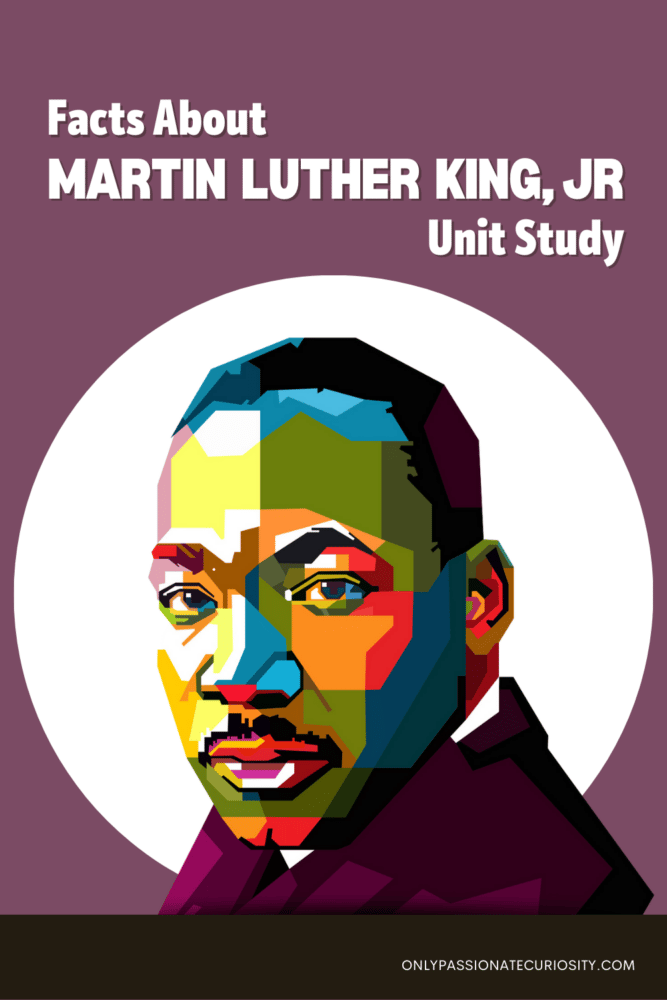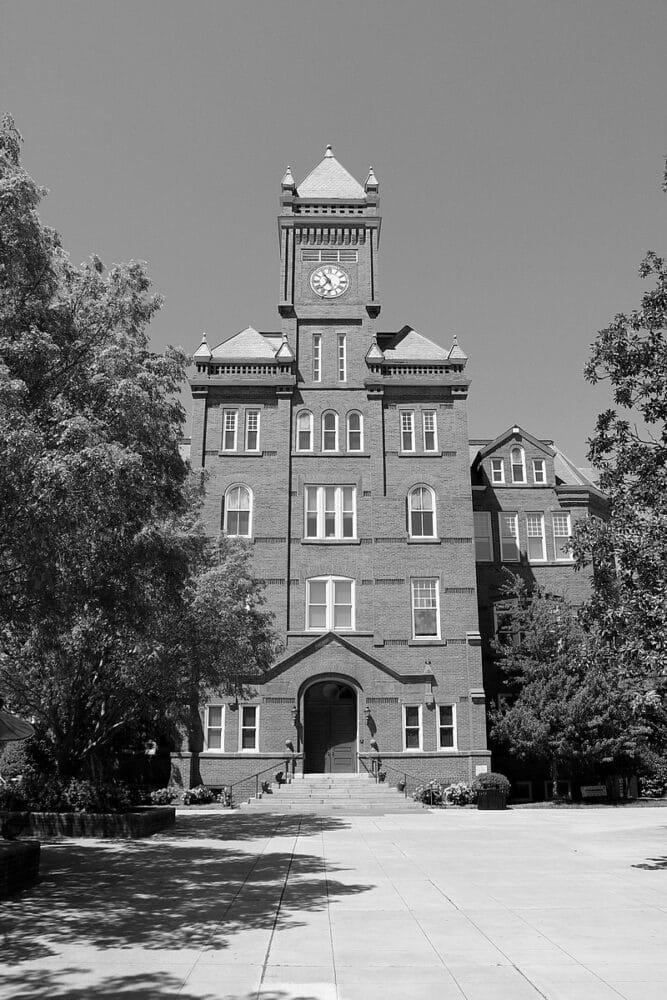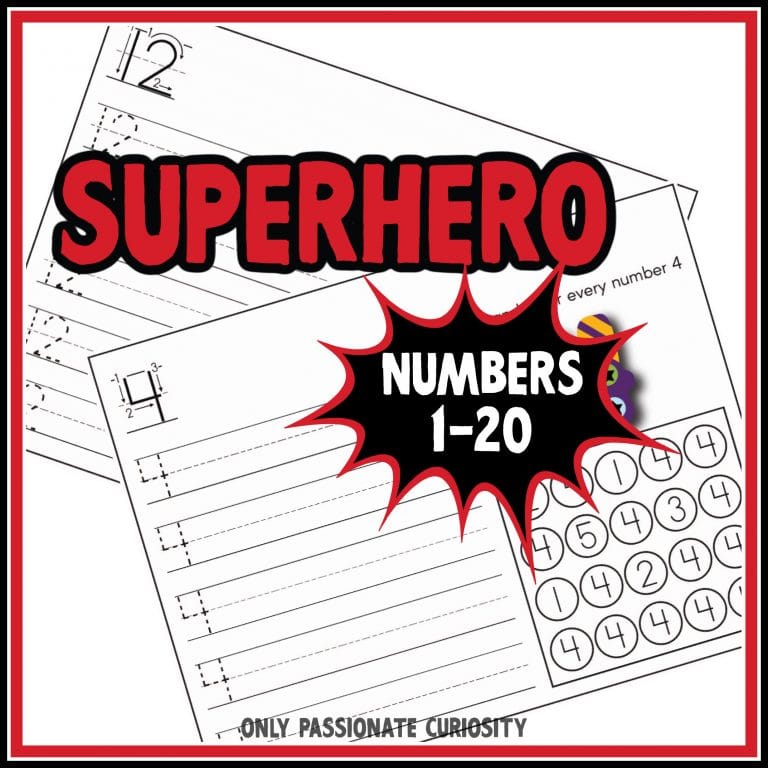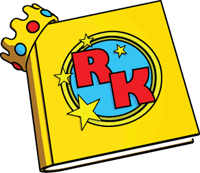80+ Facts about Dr. Martin Luther King Jr. Unit Study
Let’s learn some facts about Dr. Martin Luther King Jr., one of the most influential Civil Rights leaders in the history of the United States. He never stopped fighting against racism. Let’s learn about who he was and how he inspired millions to stand up against this injustice.
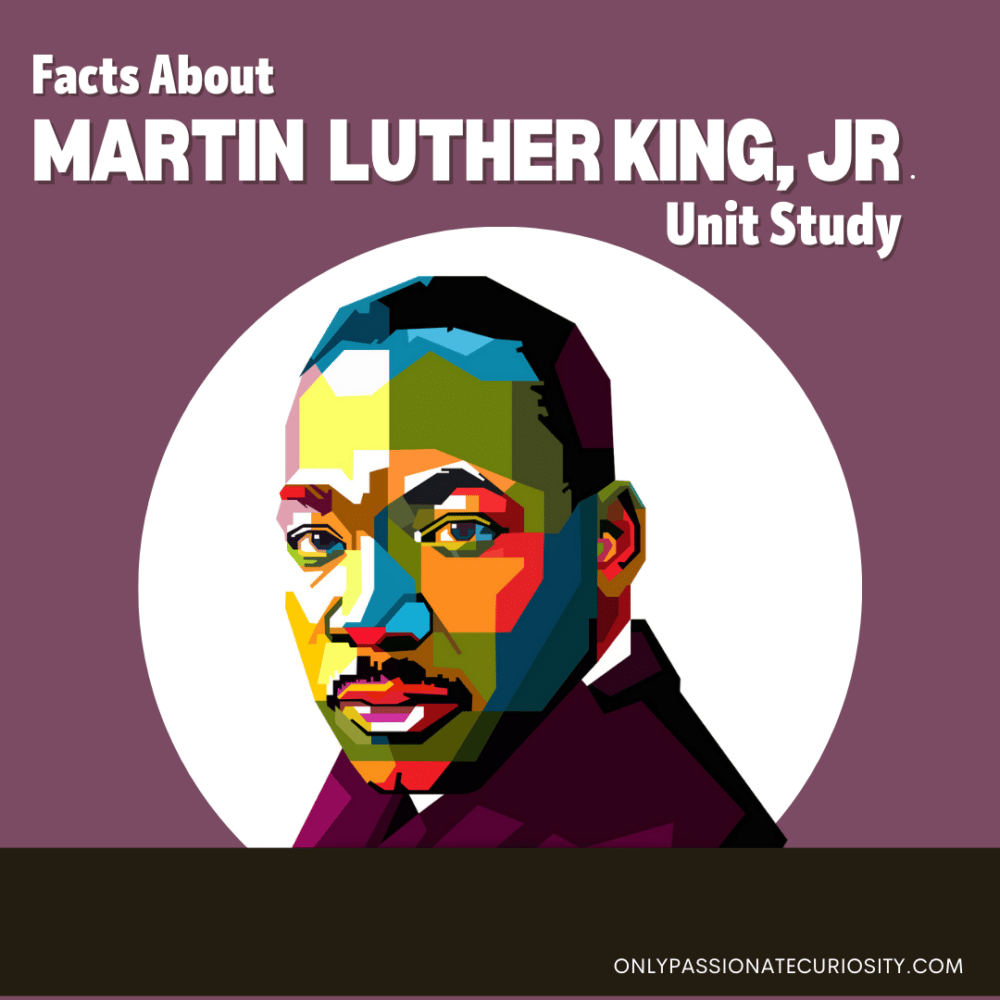
Studying Dr. Martin Luther King Jr. is one of the best ways to gain an in-depth understanding of the civil rights movement in the United States. His words and actions have had a lasting impact on our society and are still relevant today. His leadership and advocacy for nonviolent resistance to racism and injustice garnered support for the civil rights movement around the world. His legacy gave us a powerful example of how one person can impact and effect change in America.
What are 10 Facts About Dr. Martin Luther King Jr.’s Childhood?
- Martin Luther King, Jr. was born in Atlanta, GA, on January 15, 1929. He was the middle of three children. He grew up during the Great Depression. However, his family was stable and financially secure.
- When he was born, Martin Luther King, Jr. was actually given the name Michael Luther King, Jr., and most folks called him Mike or M.L. His dad, Michael Luther King, Sr. was a pastor who became inspired by the Protestant Reformation Leader, Martin Luther, so he decided to change his own name and his 5-year-old son’s name to Martin.
- His grandfather was a pastor at Ebenezer Baptist Church, and so was his dad, Martin Luther King, Sr. Martin Luther King, Jr. would be a co-pastor in this very same church.
- At the young age of six, he faced racism. He had a white friend whom he played with regularly. His dad owned a shop across the street from Martin’s home. When they entered schools, they were not allowed to attend the same school because Martin was African American, and the schools were segregated. His friend’s dad had forbidden them from playing together after that. After being banished from playing with his friend, Martin’s parents explained the realities and injustices of racism. He was encouraged not to hate the white man but to love him because that was his duty as a Christian.
- When Martin was still relatively young, he went with his father to buy new shoes. The young white clerk would not wait on them in the front and told they move to the back of the store. His dad was determined to stay where they were, or they simply would not get shoes there. The clerk insisted they move, so they left. This was Martin’s first experience seeing his dad so furious.
- Growing up, Martin had to recite a Bible verse at the dinner table before eating. It is reported that one of his favorite verses was John 11:35. “Jesus wept.” (It was easy to remember.)
- Martin Luther King, Jr. was a competent student and attended public schools. He graduated high school early, at age 15, because he skipped the 9th and 12 grades. He scored so high on the college entrance exam he didn’t formally finish high school.
- Martin Luther King, Sr., Martin’s dad, also spoke against racism. His dad “taught him respect and the importance of standing up for what you feel is right.”
- Martin Luther King, Jr. was musical. He sang in the Atlanta premier of the movie Gone with the Wind and sang baritone. He learned to play piano with his siblings from his mother, Alberta William King.
- When Martin was little, he wanted to be a fireman. Later he considered becoming a doctor. When he was just 18 years old, he became a minister in his father’s church.
Download the Facts About Martin Luther King Jr. Unit Study
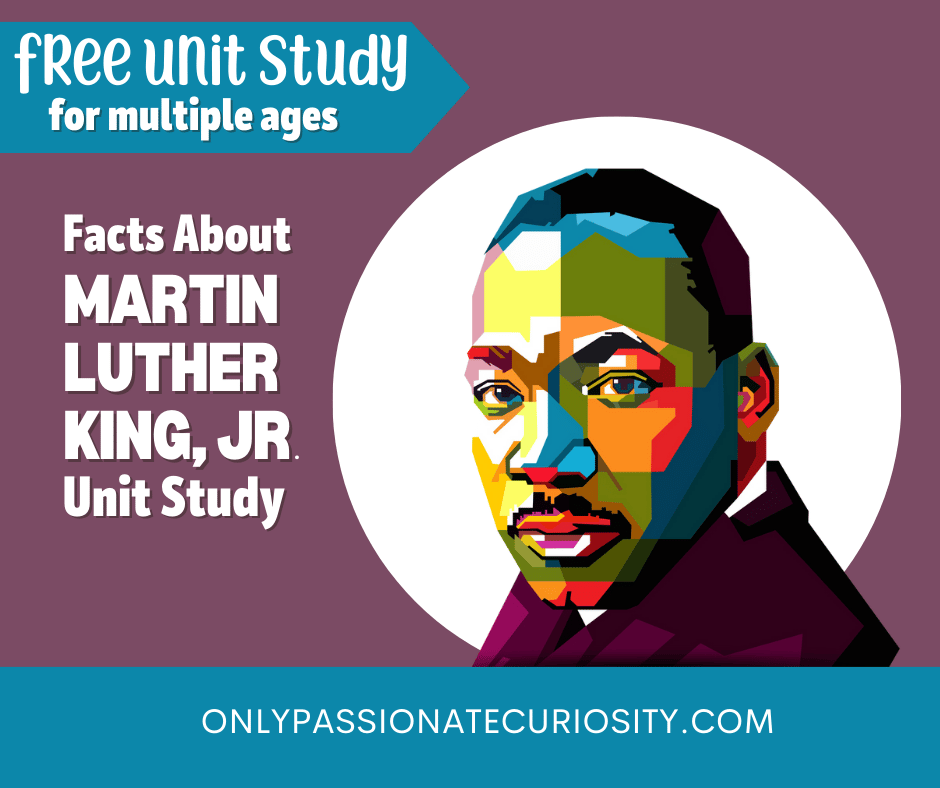
What are 10 Facts About Dr. Martin Luther King Jr.’s Morehouse College Days?
- In September of 1944, Martin Luther King, Jr. went to Morehouse College in Atlanta when he was just 15 years old.
- Both his father and grandfather had attended Morehouse as well.
- Martin was very involved in various groups on campus, including being president of the sociology club, a member of the debate team, student council, glee club, and minister’s union. He also joined the National Association for the Advancement of Colored People (NAACP).
- Martin Luther King, Jr. was considered an underachiever by many at Morehouse. However, his gift of oration was evident when he won second prize in the John L. Webb Oratorical Contest during his sophomore year at Morehouse.
- Right after his sophomore year at Morehouse, Martin Luther King, Jr. wrote a letter to the editor of the Atlantic Constitution summarizing his goals for black citizens: “We want and are entitled to the basic rights and opportunities of American citizens: The right to earn a living at work for which we are fitted by training and ability; equal opportunities in education, health, recreation, and similar public services; the right to vote; equality before the law; some of the same courtesy and good manners that we ourselves bring to all human relations.”
- He wrote an article that same year for the Morehouse paper, the Maroon Tiger, called “The Purpose of Education.” In this paper, he stated that the function of education was “to teach one to think intensively and to think critically.”
- His awareness of social and political issues grew even more, when he joined the city’s Intercollegiate Council, an interracial Atlanta students group. He said, “As I got to see more of white people, my resentment was softened, and a spirit of cooperation took its place. But I never felt like a spectator in the racial problem. I wanted to be involved in the very heart of it.” And he certainly accomplished that!
- The president of Morehouse, Benjamin E. Mays, was one of Martin Luther King’s mentors and played an important role during his college years. Martin described him as “one of the great influeneces in my life.” Mays encouraged students to struggle against segregation and often preached on Mahatma Gandhi‘s philosophy of nonviolence.
- His professors had a profound impact on him as well. Dr. George D. Kelsey, director of the School of Religion, was his favorite teacher. He inspired King to combine the tradition of religion and ministry with the modern world’s issues. Professor Samuel W. Williams introduced Henry David Thoreau’s “Essay on Civil Disobedience” to Martin. It is reported that King read the essay over and over again, utterly focused on the idea of “refusing to cooperate with an evil system.”
- Martin Luther King, Jr. graduated from Morehouse in 1948 with a Bachelor of Arts degree in Sociology. He was ordained to the Baptist ministry the same year.
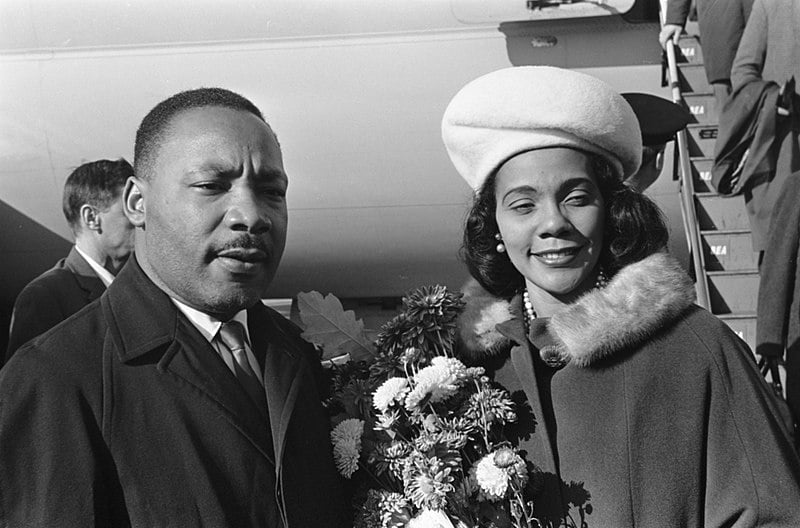
What are 10 Facts About Dr. Martin Luther King Jr.’s Young Adult Years?
- After Morehouse, Martin attended Crozer Theological Seminary in Chester, PA. He was one of only 11 African American students at the Seminary. He was elected class president in his third year at Crozer. The Dean at Crozer, Charles Batten, praised him as “one of our most outstanding students” and said he exhibited “fine preparation, an excellent mind, and a thorough grasp of the material.” Martin graduated in 1951 with a Bachelor of Divinity degree with honors as the class valedictorian (the first for an African American student) and also received the Pearl Plafker Award for Scholarship.
- Martin Luther King, Jr. won a fellowship at Boston University based on his academic performance at Crozer. He entered Boston University School of Theology in 1951.
- Martin was in Boston University’s Sigma Chapter of the Alpha Phi Alpha Fraternity, the nation’s first intercollegiate Black Greek-letter fraternity.
- Martin preached as an assistant minister at Twelfth Baptist Church (a successor to the historic African Meeting House on Beacon Hill) while pursuing his Doctorate at Boston University.
- He met his future wife, Coretta Scott, in Boston on a blind date! They met in January of 1952 at the New England Conservatory of Music, where she was a student. “I waited for him on the steps outside the conservatory on the Huntington Avenue side,” she wrote in her 1969 autobiography, My Life with Martin Luther King, Jr. “The green car pulled up to the curb, and as I walked down the steps, I could see the young man sitting in the car.” Coretta was two years older than Martin.
- He married Coretta on June 18th, 1953, while at Boston University. After graduation, they moved back to the South, settling in Montgomery, AL, where he became pastor of Dexter Avenue Baptist church.
- Coretta and Martin spent their honeymoon a funeral parlor. Honeymoon suites were off-limits for African Americans at the time. A friend, who owned the parlor, offered to let him use it for his honeymoon.
- Dr. King completed his residence for a doctorate early in 1953 and received his Doctorate in Systemic Theology from Boston University in 1955. He could not attend his graduation due to financial constraints, the cost of traveling back to Boston, and Coretta being pregnant with their first child.
- Martin Luther King, Jr. was known to have a great sense of humor and loved to laugh and get everybody else to laugh. But he only showed that side to his closest friends.
- Martin Luther King was also accepted at Yale, but he chose Boston University.
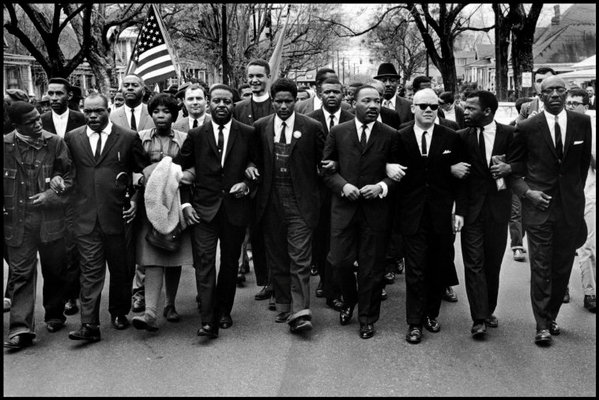
What are 10 Facts About Dr. Martin Luther King Jr.’s Civil Rights Experience?
- On December 1st, 1955, Rosa Parks refused to give up her seat on a full Montgomery bus. The bus companies’ policies held that African American passengers sat at the back of the bus and were expected to give their seats up to white passengers when the bus was full. The bus driver had Rosa Parks arrested. Martin Luther King, Jr. joins the bus boycott immediately.
- Right after Rosa Parks was arrested, black ministers and community leaders in Montgomery, AL, formed Montgomery Improvement Association (MIA) and elected Dr. King president. In doing so, he becomes the official spokesperson for the Montgomery Bus Boycott. The boycott was to be a one-day boycott on December 5th.
- At a mass meeting at Holt Street Baptist Church, King spoke to several thousand people and laid out their goals. “I want it to be known that we’re going to work with grim and bold determination to gain justice on the buses in this city. And we are not wrong.… If we are wrong, the Supreme Court of this nation is wrong. If we are wrong, the Constitution of the United States is wrong. If we are wrong, God Almighty is wrong.”
- King’s leadership in the bus boycott led to international attention on racial discrimination. The MIA’s tactics – combining mass nonviolent protest with Christian ethics – became the model for boycotting segregation in the South.
- Dr. King received regular death threats, was arrested, his home was bombed, and he was subjected to an untold amount of abuse. He was indicted in 1956 and accused of interfering with lawful business. He was tried, convicted, and ordered to pay $500. He served 386 days in jail.
- In November of 1956, the Supreme Court of the United States declared the laws surrounding segregation on boxes to be unconstitutional. You can research more about Browder v. Gayle here.
- In 1957, King formed Southern Christian Leadership Conference (SCLC) to redeem “the soul of America” through nonviolent resistance. It coordinated the action of local protest groups throughout the south.
- Now a powerful speaker, Martin delivered one of the most poignant and iconic speeches in the history of America, where he appealed to the Christian and American moral ideals. He gave the now famous “I Have a Dream” speech in Washington, DC, on August 28th, 1963, at the March on Washington for Jobs and Freedom protest. He spoke from the Lincoln Memorial, looking toward the National Mall, where over 250,000 civil rights supporters had gathered to hear him speak.
- In 1964, King was named “Man of the Year” by Time Magazine.
- That same year, in October, at 35, King was awarded the Nobel Peace Prize. He was the youngest man ever to receive the Nobel Peace Prize. He was awarded this prize “for his nonviolent struggle for civil rights for the afro-American population.” When he was notified that he had won, Dr. King announced that he would turn over the prize money ($54,600) to further the civil rights movement.
What are 10 Facts About Dr. Martin Luther King Jr.’s Assassination?
- Martin Luther King, Jr. had made enemies speaking and working for civil rights, especially in the deep South. Dr. King was in Memphis, TN with other SCLC members, to prepare to join the Memphis sanitation workers. They were striking over a long pattern of neglect and abuse of its black employees. 1,300 workers went on strike after two garbage collectors were crushed to death by a malfunctioning truck.
- On the night of April 3, 1968, the night before he was assassinated, King gave a speech at the Mason Temple Church. He ended his speech, with these words: “I’ve seen the promised land. I may not get there with you. But I want you to know tonight, that we, as a people, will get to the promised land. And I’m happy tonight. I’m not worried about anything. I’m not fearing any man. Mine eyes have seen the glory of the coming of the Lord.”
- On the following evening, Thursday, April 4th, 1968, at 6:05 pm, 39-year-old King was heading out to dinner with a local Memphis minister. He had stepped out on the balcony of room 306 of the Lorraine Motel. An assassin fired a single rifle shot at Dr. King, hitting him in the neck. An ambulance rushed him to St. Joseph’s Hospital, where he was pronounced dead at 7:05 pm.
- President Lyndon B. Johnson called for a national day of mourning to be observed on April 7th.
- On April 8th, Coretta Scott King and other family members joined thousands to march in Memphis, honoring King and supporting the sanitation workers.
- Dr. King’s funeral was held in Atlanta at Ebenezer Baptist Church, the church he grew up and served as co-pastor with his father.
- Dr. King’s mentor and Morehouse President, Benjamin Mays, delivered the eulogy. Many of the nation’s political and civil rights leaders attended, including Jacqueline Kennedy, Vice President Hubert Humphrey, and Ralph Bunche. He is buried in a crypt next to the Ebenezer Church at the King Center, an institution founded by King’s widow.
- James Earl Ray was suspected of King’s assassination. He was a fugitive who had escaped from a Missouri prison in April of 1967. An international manhunt led to his extradition from Britain to stand trial. Ray pled guilty to murder charges but later recanted his confession after being sentenced to 99 years in prison. There was lots of speculation and doubts about Ray’s guilt. In 1997, King’s family publicly supported Ray’s appeal for a new trial, and even King’s son, Dexter Scott King, supported Ray’s claims of innocence. However, TN authorities refused to reopen the case and Ray died in prison of liver failure on April 23rd, 1998.
- The Lorraine Motel, where Dr. King was shot, is now a civil rights museum.
- Dr. King survived an assassination attempt 10 years before he was murdered. On September 20th, 1958, in Harlem, Dr. King was signing copies of his new book in Blumstein’s department store. Izola Ware Curry stabbed Dr. King in the chest with a letter opener. She was charged, indicted and declared insane.
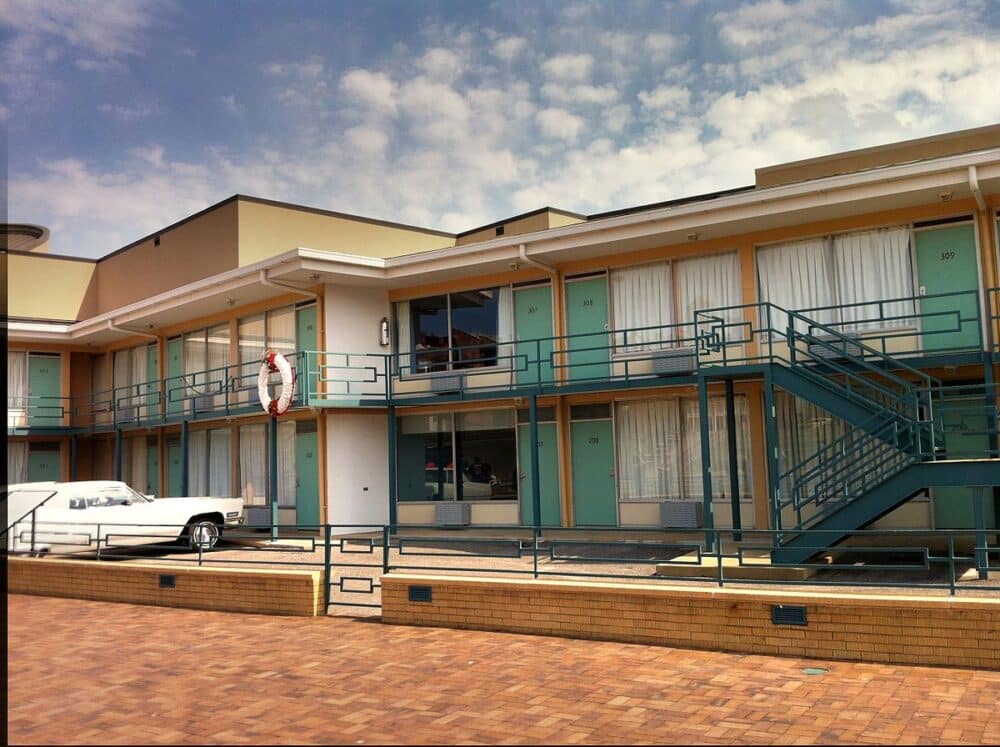
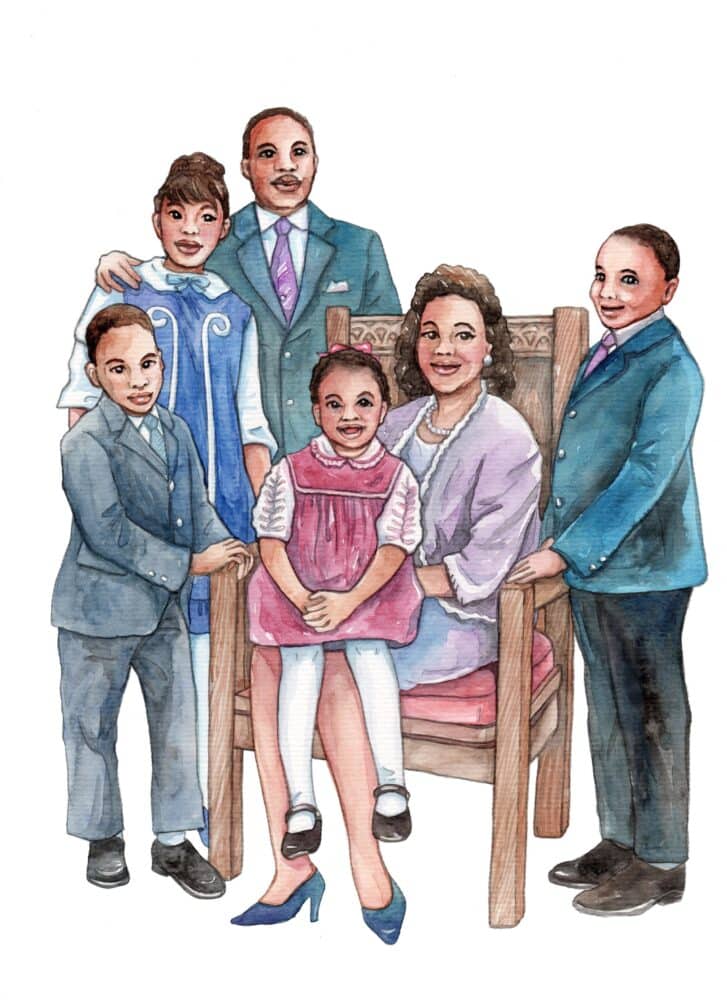
What are 10 Facts about Dr. Martin Luther King Jr.’s Family?
- Dr. Martin Luther King married Coretta Scottt and had four children – two boys and two girls. Their names are: Yolanda Denise King, Martin Luther King III, Dexter Scott King, and Bernice Albertine King.
- Coretta Scott was born April 27, 1927 and was two years older than her husband. She was a huge advocate for her husband during his life and a torch bearer for his life’s work in the civil rights movement. She founded the King Center and was instrumental it getting his birthday instituted as a national holiday. In August of 2005, she had a stroke that left her right side paralyzed. She died January 30, 2006 from complications associated with cancer.
- Yolanda Denise King was the first born child. She was born a month before the Montgomery Bus Boycott on November 17, 1955. She was 12 years old when her dad was assassinated. She died May 15, 2007 of a chronic heart condition at the age of 51 years old.
- Martin Luther King III was born October 23, 1957 and is the oldest son. He was named after his father, although his mom, Coretta, worried about doing so. When he was little, they called him “Marty.” He was 10 years old when his father was assassinated. He was the President of the Southern Christian Leadership Conference from 1997 to 2004.
- Dexter Scott King was born January 30, 1961 and was named after the Dexter Avenue Baptist Church in Montgomery, AL where his dad was a pastor. He was 7 years old when his father was assassinated. He played trumpet when he was in high school. He is hte chairman of the King Center. He has portrayed his father in movies and TV. One of his films, “Our Friend Martin” was nominated for an Emmy in 1999.
- Bernice Albertine King was born March 28, 1963 and is the youngest child. She was just 5 years old when her dad was assassinated. She is a lawyer and minister. She briefly served as president of the Southern Christian Leadership Conference in 2009 and was the first woman elected to that position. She is the CEO of the King Center. When she was just 17, she spoke at the United Nations.
- All of the King children took theater classes. The school they took from was one of the few that was not segregated. Julia Roberts’ family owned a theater school in Atlanta. When Coretta Scott King called to see if they would accept her children into the school, they welcomed them in. Their families became fast friends. When Julia Roberts was born, her family could not pay the hospital bill. Dr King and Coretta paid the bill.
- Coretta Scott King established The King Center for Nonviolent Social Change (The King Center) in 1968 in Atlanta, GA after Dr. Martin Luther King Jr.’s death. Almost 1 million people visit the center each year. Dr. King and Coretta both are buried here. It’s primary focus over the years has been preserving the legacy of the Dr. King and on inspiring and teaching new generations to carry his message into the future. They have evolved into being a center for research, education, training, advocacy, and activism.
- Dr King and Coretta only have one grandchild, a daughter born to Martin Luther King, III. Her name is Yolanda Renee King. She was born May 25, 2008. She is already carrying on the family tradition of supporting nonviolence. You can watch an interview with Yolanda below.
- Alveda Celeste King is the niece of Dr. Martin Luther King Jr. She is the daughter of Dr. King’s brother, A.D. King and his wife, Naomi Barber King. Alveda was born in Atlanta on January 22, 1951. She was a politician in the Georgia House of Representatives from 1979 to 1982. Alveda is also an outspoken and popular speaker on racism and civil rights. She is a Christian and is a prolific writer. She has written 10 books so far.
What are 10 Facts about Dr. Martin Luther King Jr.’s Legacy?
- Right after Martin Luther King’s death, Lyndon B. Johnson urged Congress to pass the pending civil rights legislation. Just days later, Congress passed the Civil Rights Act of 1968. Title VIII, commonly known as the Fair Housing Act. This Act made it illegal to discriminate in housing based on a person’s race, religion, or home country.
- After he died, President Jimmy Carter awarded Dr. King the Presidential Medal of Freedom. Also, Dr. King and his widow, Coretta, were awarded the Congressional Gold Medal.
- In 1986, President Ronald Reagan signed the legislation creating a national holiday in honor of Dr. King. Martin Luther King Jr. Day is celebrated on the third Monday of January every year. Learn about Dr. Martin Luther King Day here.
- In 2003, the United States Congress approved a law allowing the beginning words of Dr. King’s famous speech “I Have a Dream” to be carved into the Lincoln Memorial. He stood at the Lincoln Memorial when he delivered the I have a Dream speech.
- More than 900 streets in the United States have been named after Dr. Martin Luther King Jr.
- In 2011, a memorial statue of King was erected in West Potomac Park next to the National Mall in Washington, DC.
- There are memorials around the world in his honor. Some countries include Hungary, South Africa, Israel, Ghana, India, and many more. Westminster Abbey in London, England, is one of the most notable religious buildings. All coronations of monarchs happen here as well as sixteen royal weddings. It became one of Britain’s most significant honors to be buried or commemorated in the Abbey. Above the Abbey’s Great West Door stand ten statutes to modern martyrs – Christians who gave up their lives for their beliefs. His statue was unveiled in 1998.
- King appealed to the conscience of each American, gathering support for civil rights reform through nonviolent protests and interracial cooperation and conversation. This tactic enabled him to fight effectively against the legalized racial segregation and discrimination.
- Martin Luther King’s legacy is that he was able to combat injustice by appealing to Americans’ highest aspirations. He was the conductor of the nonviolent civil rights movement and certainly among the twentieth-century’s most influential people.
- King made it legal for each of us to expect — regardless of skin color, gender, ethnicity, or economic means — to be treated fairly, with dignity and respect.
What are 10 Facts About Dr. Martin Luther King Jr. You Might Not Know?
- Martin Luther King Jr’s “I Have a Dream” speech was not the first time he spoke at the Lincoln Memorial on the National Mall. Six years earlier, during the Prayer Pilgrimage for Freedom on May 17th, 1957, he spoke in front of 25,000 people on the same topic of civil rights and voting rights. He asked America to “give us the ballot.”
- Dr. King was in jail almost 30 different times! According to the King Center, he was jailed 29 times, usually for acts of civil disobedience.
- Dr. King’s mother, Alberta Williams King, was murdered in the Ebenezer Baptist Church in Atlanta. On June 30th, 1974, Marcus Wayne Chenalut Jr sat in the front pew of the church. He stood up and drew two pistols, and began firing. 69-year-old Mrs. King played the organ and was gunned down just feet from where her son preached on nonviolent protests.
- Famous musician Stevie Wonder wrote a song to honor Dr. King after his death.
- Little Martin was kicked out of first grade. Why? Because he was too young to enter school, per the school’s entry requirements. He was quite advanced and skipped two grades (ninth and 12th) due to his academic skills.
- Martin Luther King Jr. ran a paper route when he was young. He had quite the work ethic. Martin was promoted to assistant manager for The Atlanta Journal delivery station when he was only 13, making him the youngest assistant manager.
- Dr. King didn’t always plan to be a minister like his father and grandfather. He initially thought he would be a doctor or a lawyer.
- Dr. King was awarded more than 20 honorary degrees. Even though he went to school and studied for three of his degrees, including his doctorate, he was bestowed many honorary doctorates from universities worldwide. A few notable ones were Howard University, Yale, Wesleyan, and many more.
- Dr. King wrote five books: Stride Toward Freedom, Where do We Go From Here, Why We Can’t Wait, Strength to Love, and The Trumpet of Conscience.
- Even though Dr. King was one of history’s most renowned public speakers, he received a C and a C+ in his public speaking courses at Crozer Theological Seminary.
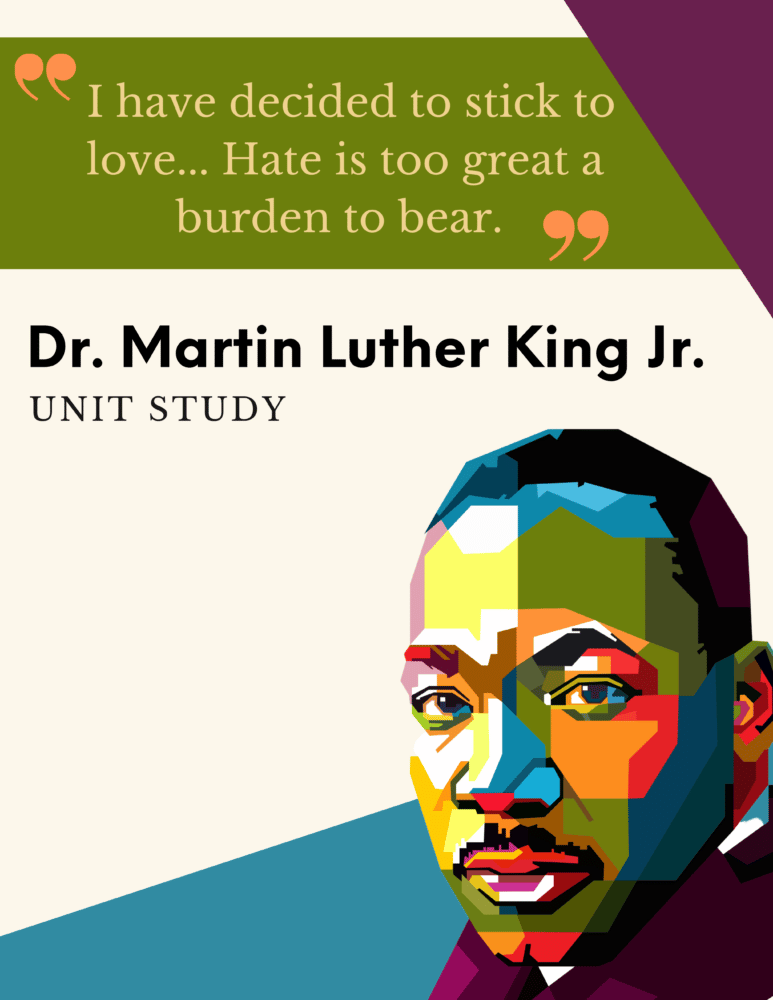
We hope you have enjoyed learning through these facts about Dr. Martin Luther King Jr!. We have created a 100 plus page unit study and work book that goes with this article. It is filled with resources from art projects, time lines and crossword puzzles to color-by-number pages, EduBingo, and drawing activities. You can download your free copy of the unit study below.
Download the Facts About Martin Luther King Jr. Unit Study




